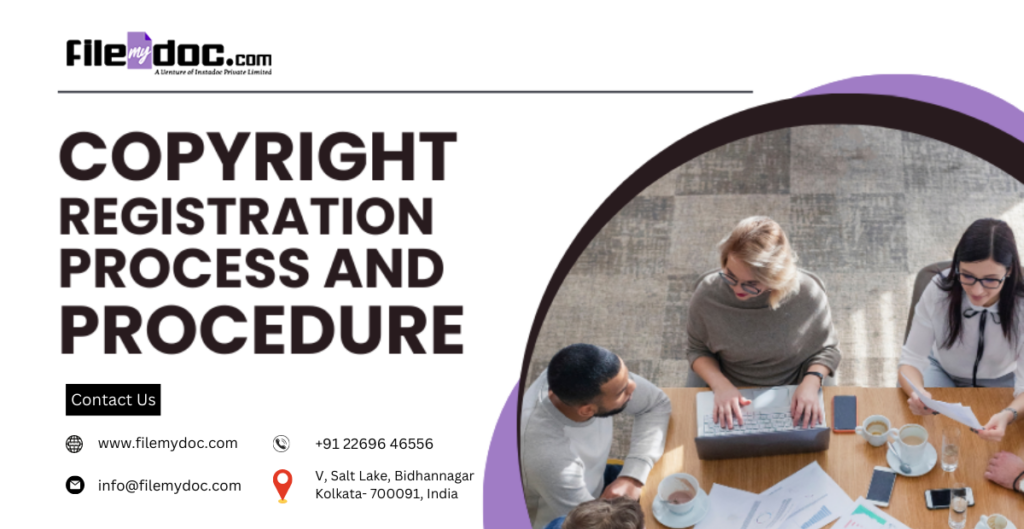Introduction
Copyright registration is an important step in protecting creative works and ensuring the rights of creators are safeguarded. This article explores the process and procedure of copyright registration, highlighting its significance, the requirements for registration, the steps involved, and the benefits of obtaining copyright protection.




Importance of Copyright Registration
Copyright registration serves as evidence of ownership and provides legal protection to original works of authorship. It grants creators exclusive rights over their creations, including the right to reproduce, distribute, display, perform, and create derivative works. By registering a copyright, creators establish a public record of their ownership, which can be crucial in cases of infringement or disputes.
Copyright Registration Requirements
To be eligible for copyright protection, a work must meet certain criteria. The work must be original, meaning it must originate from the author and display a minimal degree of creativity. Additionally, it should fall within the categories of copyrightable works, such as literary, artistic, musical, or dramatic works, among others. However, copyright does not protect ideas, facts, or common information.
Copyright Registration Process
The copyright registration process involves several steps. While copyright protection automatically exists upon the creation of a work, registration provides additional benefits, including legal advantages and evidence of ownership. The following steps outline the copyright registration process:
Step 1: Gathering the Required Materials The first step is to gather all the necessary materials for the registration process. This includes the work itself, such as a manuscript, recording, or artwork, as well as supporting documents, such as a completed application form, the appropriate filing fee, and any additional materials required for specific types of works.
Step 2: Completing the Application Form The next step is to complete the copyright application form. The form requires information about the work, including its title, authorship details, publication details (if applicable), and a brief description. It is important to provide accurate and detailed information to ensure a smooth registration process.
Step 3: Submitting the Application Once the application form is completed, it needs to be submitted to the copyright office. In many countries, including the United States, this can be done electronically through an online portal. The filing fee must be paid at the time of submission. The copyright office will provide a receipt or acknowledgment of the application.
Step 4: Waiting Period After submission, there is typically a waiting period before the registration is processed. The duration of this period varies depending on the copyright office’s workload and policies. During this time, the application is reviewed, and any additional information or clarification may be requested.
Step 5: Examination and Correspondence In some cases, the copyright office may examine the application and correspond with the applicant if further information or modifications are required. This may involve responding to queries, providing additional documentation, or making amendments to the application.
Step 6: Registration and Certificate Once the examination process is complete, and the application meets all requirements, the copyright office will issue a registration certificate. This certificate serves as an official confirmation of copyright registration and includes important details such as the title of the work, the author’s name, and the registration number. The certificate provides prima facie evidence of ownership in case of infringement or legal disputes.
Benefits of Copyright Registration
Obtaining copyright registration offers several benefits to creators. Firstly, it provides legal evidence of ownership, making it easier to enforce copyright and take legal action against infringers. Copyright registration is often a prerequisite for filing a lawsuit in cases of infringement.
Additionally, copyright registration allows creators to claim statutory damages and attorney fees in infringement cases. This provides a significant advantage, as statutory damages can be substantial and act as a deterrent against potential infringers.
Furthermore, copyright registration enhances the market value of creative works. It facilitates licensing and allows creators to monetize their creations by granting permission for use or reproduction. Copyright registration also strengthens the credibility and recognition of works, as it demonstrates the author’s commitment to protecting their intellectual property.
Moreover, copyright registration offers international protection through reciprocal agreements between countries. This enables creators to assert their rights in foreign jurisdictions, expanding their market reach and opportunities for licensing or distribution.
Conclusion
Copyright registration is a crucial process for creators to protect their original works and establish legal rights. By understanding the requirements and following the registration process, creators can ensure the security and recognition of their creative endeavors. Copyright registration provides tangible benefits, including legal protection, evidence of ownership, and opportunities for monetization, enabling creators to fully leverage their artistic works.


























